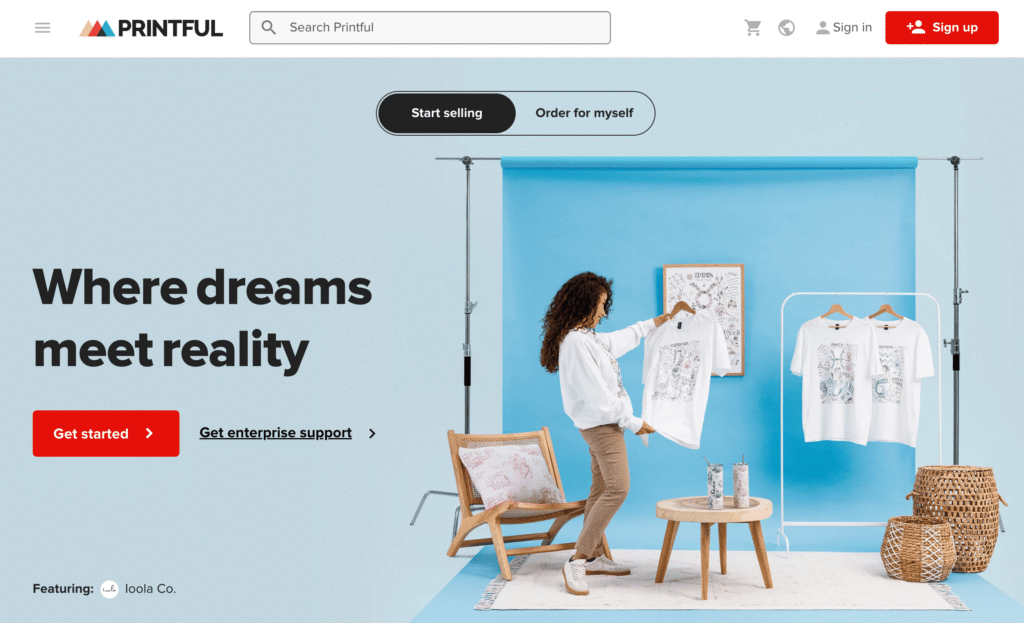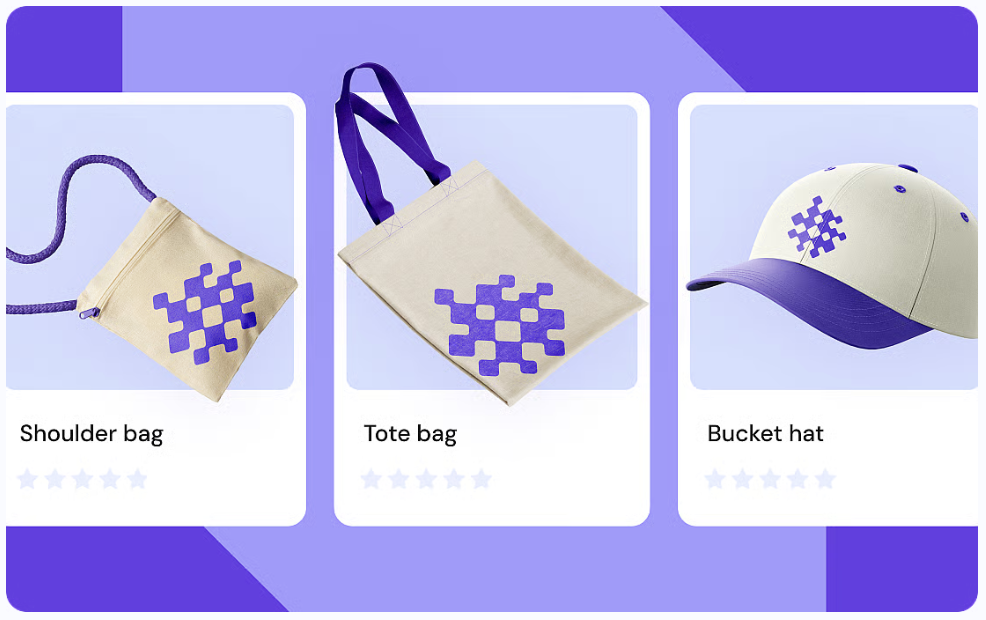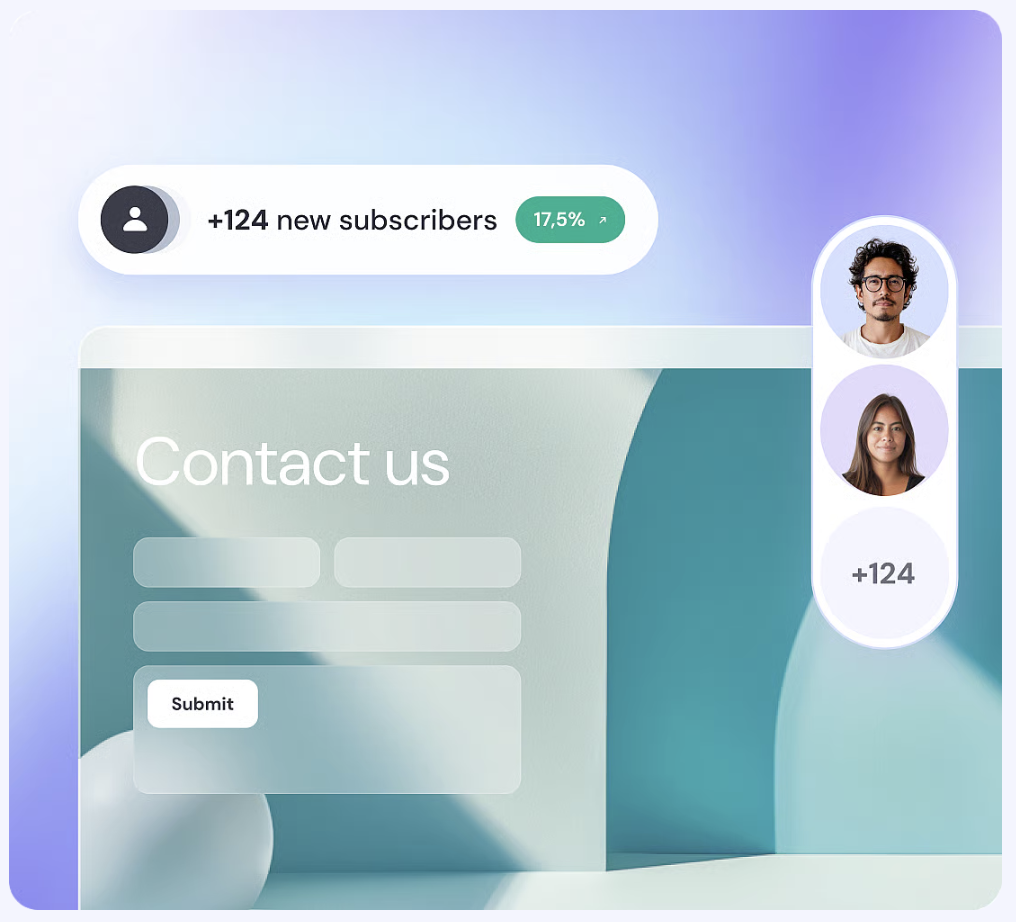How to make money with print on demand

Print on demand is a business model where you sell custom-designed products without holding any physical inventory. You partner with a third-party supplier that prints your designs on items like t-shirts or mugs after a customer places an order, and they handle the shipping for you.
This makes print on demand an excellent way to make money online with minimal financial risk. Instead of investing thousands in bulk inventory upfront, you only pay your supplier after a customer has already paid you.
The key to profitability? Focus on unique, high-quality designs tailored to a specific niche, united by a distinct brand identity and original artwork. This is what helps you stand out in a competitive market.
Putting that strategy into action breaks down into eight steps:
- Find your niche. Identify a specific audience with clear interests and proven buying potential.
- Partner with a supplier. Choose a reliable print-on-demand company to handle manufacturing and shipping.
- Create unique designs. Develop original artwork and compelling graphics that appeal directly to your chosen niche.
- Build your digital storefront. Set up an online store to sell your products with a cohesive brand presence.
- Set strategic prices. Calculate your costs to determine prices that are both competitive and profitable.
- Market your business. Promote your products and drive traffic to your store through multiple channels.
- Manage customer orders. Oversee orders and provide excellent service while your supplier handles fulfillment.
- Review your performance. Use sales data to refine your designs, products, and marketing strategies over time.
1. Choose a profitable niche
Choosing a niche means focusing on a specific group of customers with a shared passion, like rock climbers or classic car enthusiasts, instead of trying to sell to everyone. This focused approach lets you sidestep competition from major retailers, makes your marketing laser-targeted, and builds customer loyalty because your designs show you truly understand them.
A profitable niche sits at the intersection of your interests and what people actually buy. But the real magic happens when you bring a unique angle that makes your brand memorable.
For example, instead of tackling the oversaturated “dog lovers” market, you could focus on corgi owners with designs celebrating their dogs’ quirks, like their signature sploots or stubborn personalities.
To find your niche, start by listing your hobbies, interests, or communities you’re part of. Once you have several ideas, validate their profitability by researching competitors on marketplaces like Etsy or Redbubble. Look for positive signals like Bestseller badges and shops with thousands of sales—this proves real demand exists.
Next, verify search interest is stable or growing by checking commercial keywords like “[your niche] gifts” using tools like Google Trends. Finally, confirm the community actively buys by exploring niche-specific Facebook groups, subreddits, or Instagram hashtags where members share products they’ve purchased.
2. Select a print-on-demand provider
A print-on-demand provider is the company that physically produces and ships your products to your customers. Choosing the right partner is critical because they directly control product quality and the delivery experience – two factors that make or break customer satisfaction.
Popular and reputable companies like Printful, Printify, and Gelato are excellent starting points.

Once you have a shortlist, compare providers on these key factors:
- Product catalog. Verify their product range aligns with your brand and niche. For example, an eco-conscious store needs a provider with robust organic or sustainable options.
- Overall costs. Calculate your true cost per item by factoring in production fees, shipping rates to your primary markets, and any monthly subscription fees. A low product price means nothing if shipping costs devour your margins.
- Reliability and reviews. Read recent independent reviews focusing on print quality and fulfillment times. Look for consistent patterns, but don’t stop there – always order samples yourself. Testing the actual product quality and shipping speed firsthand is the only reliable way to evaluate a potential partner.
3. Design your products
To create sellable designs, you need high-quality, original artwork that resonates with your niche. You can use tools like Canva for accessible templates, hire designers on platforms like Fiverr or Upwork, or leverage AI image generators like Midjourney. If using AI, verify you have full commercial rights by reviewing the platform’s Terms of Service, as licensing varies significantly between providers.
Follow two essential rules when designing: First, respect copyright by using only original art or properly licensed assets. Second, design for the specific product. What works beautifully on a poster may fail on a phone case, so always reference your supplier’s templates for correct dimensions and safe zones.
All design files must be high-resolution (at least 300 DPI) and saved as transparent PNGs to ensure clean printing on products of any color. Use professional mockups to showcase your designs in your store. Before launching, always order physical samples to verify print quality, color accuracy, and placement yourself.

4. Create your online store
Building your own website is the most effective way to establish a profitable, long-term print-on-demand business. It gives you complete control over your brand, higher profit margins, and ownership of your customer list for direct marketing.
To create your online store, start by establishing your brand foundation. Develop a memorable clothing brand identity with a distinctive name, logo, and values that resonate with your target audience.
Handle the essential business setup as well. Choose a business structure and open a separate bank account to keep your finances organized from day one.
Next, select an ecommerce platform to build your website. This is where you’ll showcase your products using professional mockups, write compelling descriptions, and configure payment and shipping options.
Platforms like Hostinger’s print-on-demand store builder streamline this process with direct Printful integration, automatically syncing your products and fulfilling customer orders.

5. Price your products
To price your print-on-demand products, start by calculating your total cost per item. This includes the base price your provider charges, shipping fees, and any variable costs like platform transaction fees or paid advertising expenses.
Your retail price must cover these costs while leaving room for your desired profit margin. This ensures you’re building a profitable business, not just breaking even.
However, pricing isn’t purely mathematical – it must also align with market expectations and reflect the value of your designs. Before finalizing prices, research what competitors charge for similar items in your niche. A generic t-shirt may need competitive pricing, but a truly unique or clever design carries higher perceived value and can command a premium.
Finding the right balance between your costs, market rates, and the value you deliver is the key to learning how to price your product effectively.
6. Promote your products
To effectively promote your print-on-demand products, focus on three core strategies: social media engagement, search-optimized content, and email marketing.
Start by sharing high-quality mockups on visual platforms like Instagram, Pinterest, and TikTok. Build brand awareness and drive traffic by actively engaging with your niche community. Use relevant hashtags, comment on posts, and participate in conversations where your audience gathers.
Beyond social media, attract customers already searching for products like yours by creating helpful content on your website. Blog articles like “10 Best Gift Ideas for Hikers” can naturally feature your products while ranking in search engines. This is a powerful, long-term strategy to promote your website through organic traffic.
Once you’re driving visitors to your store, focus on building a loyal audience. Encourage sign-ups with a first-purchase discount to grow your email list. This gives you direct access to announce new designs and run exclusive promotions, making email one of your most valuable channels for repeat sales.
The process becomes even simpler if you build your store using Hostinger Website Builder. It automatically syncs your website subscribers directly into Hostinger’s AI email marketing tool, giving you integrated store management and email campaigns in one platform.

7. Fulfill orders
While your print-on-demand provider handles the physical printing and shipping, you’re responsible for overseeing the fulfillment process to ensure it meets high standards.
This involves two key areas: monitoring the operational workflow with your provider and managing all customer communication about orders.
Maintain high operational standards by regularly checking your order dashboard to confirm new orders sync correctly with your provider and enter production without errors. Track your provider’s average production times. If delays become consistent, update the shipping estimates on your website accordingly.
Treat customer feedback about print quality as a remote quality control system. If you notice a recurring issue with a specific product, pause it and investigate immediately rather than waiting for more complaints.
Strong communication is equally critical to excellent fulfillment. Set clear expectations on your website with realistic production timelines and a transparent return policy. When errors occur, act as a swift intermediary between your customer and provider to arrange immediate replacements.
This combination of diligent operational oversight and proactive customer communication is what builds a trusted brand.
8. Analyze and optimize
To grow your business, regularly analyze your data to understand what’s working and what isn’t, then use those insights to make informed decisions.
Focus your analysis on four key areas:
- Product and store performance. Dive into your analytics to track metrics like conversion rate and average order value. Use this data to discontinue underperforming designs, create variations of your bestsellers, and A/B test product images or descriptions to identify which changes boost sales.
- Marketing channel effectiveness. Review which channels drive your most valuable customers. If Pinterest generates 80% of your revenue while other platforms underperform, concentrate your efforts where they deliver the best return.
- Seasonal trends. Look for patterns in your sales history. Notice spikes around holidays like Halloween or Valentine’s Day? Plan ahead by launching relevant designs and promotions a few weeks early to capture peak demand.
- Customer feedback. Treat reviews and customer emails as direct guidance for improvement. If multiple customers request a popular t-shirt design on a hoodie, you’ve found a pre-validated product opportunity worth launching.
Can you make a good profit from print on demand?
Yes, you can absolutely make a good profit from a print-on-demand business. The key to profitability lies in selecting a specific niche and creating high-quality, unique designs that resonate deeply with your target audience.
While some markets are competitive, the print-on-demand industry continues to grow, leaving ample opportunity for new stores to establish a strong brand identity.
Profitability also depends on smart business practices. These include managing costs through organic marketing channels, pricing products based on perceived value, and providing excellent customer service to drive repeat purchases.
When you treat it as a serious business and focus on these fundamentals, print on demand is profitable and can evolve from a side project into a sustainable income stream.
How much can you make from print on demand?
Your income from a print-on-demand business can range from a few hundred dollars monthly as a side hustle to thousands annually for a full-time operation.
For beginners, a realistic first-year goal is earning $100 to $500 per month while you learn the fundamentals and build an audience.
Several factors determine how you can make money with print on demand: the appeal of your niche, the quality of your designs, your marketing effectiveness, and your profit margins.
A seller with unique designs in a passionate niche who actively markets their products will consistently earn more than someone who uploads a few designs and waits for sales.
What can you sell with print on demand?
With print on demand, you can sell a wide variety of products without holding inventory. The most popular items are apparel like t-shirts, hoodies, and sweatshirts, which offer constant demand and excellent canvases for creative designs.
Beyond clothing, accessories like tote bags, phone cases, and hats perform well. Homeware represents another major category, including coffee mugs, posters, pillows, and blankets.
The product selection continues to expand, allowing you to serve virtually any niche. For inspiration, explore current trending products to discover new opportunities for your store.
All of the tutorial content on this website is subject to Hostinger's rigorous editorial standards and values.


